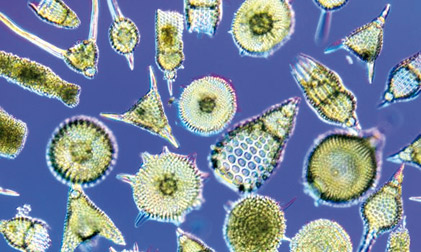'Ocean census' scientists taken aback by diversity
by Frank POPE
Oceanographers hoping to create a comprehensive census of marine life
feel that their task is far bigger than imagined.
During some 300 voyages scientists of the 10-year Census of Marine
Life have been sampling plankton, microbes and sediment-dwellers, but
the rate at which they made new discoveries - including a bacterial
community the size of Greece on the seabed near Chile - is forcing them
to reappraise their estimates of how much they know.
 |
|
Light micrograph of an
assortment of radiolaria, a type of marine protozoa |
"There are many more species than we thought there were," Dr Ann
Bucklin, head of the University of Connecticut Marine Sciences
Department, who headed up the team investigating zooplankton, told The
Times. "It turns out the ocean food web is much more complex than we
thought it was, in terms of the number of different species."
The team used DNA-sampling techniques to catalogue the life they
found, but other techniques have not changed much since the first
oceanographic expedition, conducted by HMS Challenger in 1872. Huge nets
were dragged through the deep sea between one and five kilometres
beneath the surface. Some samples were kept for taxonomic study, while
others were probed for their DNA. Now, as then, new species and genera
were found with every trawl.
Related Links Journey to the bottom of the world Himalayan glacier
error 'wake-up call' to IPCC Some scientists believe that this diversity
is redundant, and can be removed without losing essential linkages in
the food web, but many fear that losing them makes entire ecosystems
fragile.
"We've already seen the North Sea become inhospitable to a northern
species of zooplankton which is a critical part of the diet for
commercial fish species, and it's been replaced by its southern cousin,"
Dr Bucklin said. Dr Paul Snelgrove, of Memorial University,
Newfoundland, also worked on the census of "hard to see" marine
organisms. "Historically we've often dealt with these plankton species
in box models, where we don't really worry about species. Now we know
that different species do very different things," he said.
Some species thought to be from different families were discovered to
be the same. When larvae of tapetails, bignose fishes and whalefishes
were recovered from five kilometres down, they were all found to simply
be developmental stages of the same organism.
The team discovered that in the deep, rarity is common. "In many
types of ocean systems there are a few things that are very abundant,
but lots and lots of things that are extremely rare. This is true for
microbes, plankton and benthos," Dr Snelgrove said.
"That raises the question what role they play. What we don't know is
if these rare things are common somewhere else, or is it just their
nature to be rare. Do they do anything? Or are they trivial players on
the sidelines? We don't know."
Dr Snelgrove admits that the rarity may be because of how little
sampling has been done in the deep. "Globally in the history of science
we've probably sampled a few football fields' worth of the deep sea, and
that's it. We're trying to extrapolate up from that," he said.
Life on the seabed is also profuse. "If you take a bottom photograph
it looks like there's not much there, but if you actually collect the
sediment and bring it up you find it's crawling with all sorts of
things," said Dr Snelgrove.
"One study found 700 new species of crustaceans in an area the size
of a small bathroom."
On the seabed off Chile, Dr Victor Gallardo of the Census team
discovered thick mats of white, spaghetti-like bacteria that cover an
area the size of Greece. The strands - reaching the length of a human
finger - thrive by absorbing methane from the seabed. Similar mats have
been found in human-caused oxygen-free "dead zones", such as those found
beneath unregulated fish farms.
"These things may be tiny individually but altogether they are a huge
fraction of the biomass of ocean life. Not only are they beautiful, but
they're very important ecologically," said Anne Bucklin.
"How could we have missed so much? It's because we relied on our
eyes, but these are tiny little things and they're difficult to
discriminate.
"It wasn't until DNA sampling that we realised that, oh my goodness,
we're farther down the discovery curve than we thought we were." |

